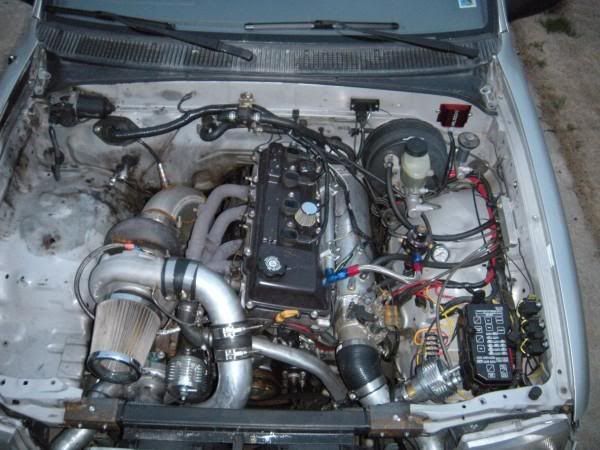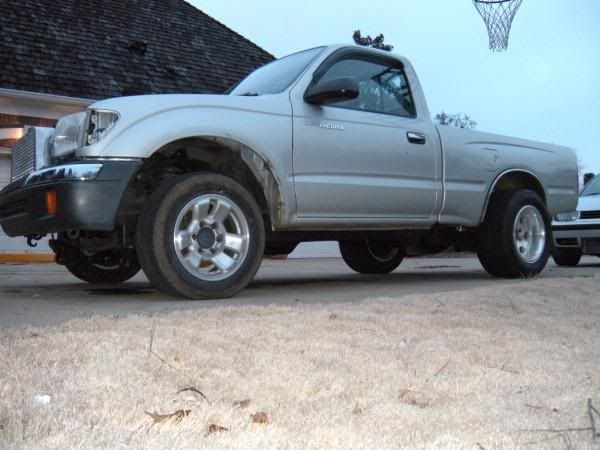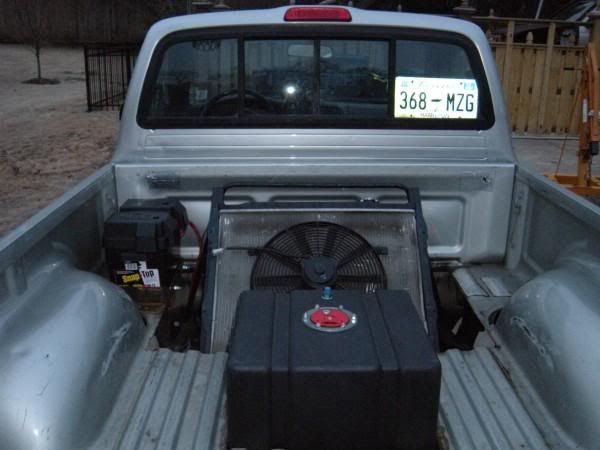20psi at 2800 rpm's. 800rwhp. Compound turbos!
- Thread starter tekdeus
- Start date
You are using an out of date browser. It may not display this or other websites correctly.
You should upgrade or use an alternative browser.
You should upgrade or use an alternative browser.
My friend Randy who does tractor pulling has a triple turbo compound set up on a v-8 alcohol injected motor with custom pistons that have the entire comb. chamber in the piston. I should drive over and take a pic of that. He runs 100+ psi. Very high dollar set up.
figgie;1252519 said:nice try but nope.
The math just does not add up.
So either you misred, he misread. Or someone is fibbing.
Using the compressor map of the GT35r (which is publicly available through Honeywell/Garrett). With some quick math. Assuming a 100% VE throughout the engines RPM for that 2.7L engine (which in this planet and reality, no turbo engine even comes close to 100% VE).
The GT35r BARELY comes out of surge at 3500 RPM at about 65% efficency flowing a mere 23.96 lbs/min. The bad part is that it WILL be teetering on the surge line on that tiny an engine.
So care to try again or should I continue to trump your ancedotal "evidence" with math and physics?
Actually, the math does add up!!! the problem is you aren't using the proper elements that are being affected. In any turbo setup weather gas or diesel you have to equate your manifold pressure in relation to absolute pressure(atmospheric pressure). Atmospheric pressure at sea level is 14.7psi or 1 bar. When a turbo makes boost it is simply compressing atmospheric pressure. So when a stock ct26 is making 14psi or 1bar there is actually 2 bar or 29.4psi coming out of the turbo, but you most subtract atmospheric pressure because it is neither created or lost(except in a vacuum).
So the simple equation is 1 bar(atmospheric pressure) + 1 bar(what the turbo produces) = 2bar - 1bar(atmospheric pressure) = 1 bar manifold pressure!!!! Thus the turbo is working in a 2:1 ratio.
Now when turbo's are compounded, one compressor is feeding the inlet of the second. The boost made by the first turbo is multiplied by the second turbo by a ration of 2:1 when using two turbos and 3:1 using three. and on, and on.
Example: 1bar(atmospheric pressure)+1bar(first turbo)=2bar, 2bar into second turbo(at a ratio of 2:1)=4bar-1bar(atmospheric pressure)=3bar manifold pressure!!!!!!
Thats 3bar or 45psi at the manifold, minus 2to3 psi for any loses like massive intercoolers and such. This is the secret that diesel guys have been using for years to make over 150psi with three turbo's compounded. And almost no one has tried it on any gas motors. I am currently running a compound setup on my 2000 Tacoma (pictured above). My brother and I have done all the fab. work and R&D. Running two 44mm wastgates with 4-7psi springs and no boost controller i've seen 25+psi before 3500rpms in 4th gear WOT. I'm running a GT45 into a TO4E t3/t4 50trim comparable to a GT30. The TO4E makes 5psi at 2krpms and the big one make 5psi around 3krpms. Some when the big turbo spools and the little one starts compounding it. The boost shoots from 10psi to 25psi+ with in 500rpms when loaded in 4th gear. Thats 25psi by 3500rpms!!!!! And my clutch starts slipping. Its is a stage 4 six puck competition clutch with 250% increase torque capacity, and it can't hold it since the power is coming on so FAST!!!!!!!
I'll be glad to answer any question. I'm going out of the country tomorrow and won't be back until the 9th. Vids will be up some time in march. I've been driving my truck daily since i got it running two months ago and no problems from the setup. Absolutely no lag!!!!!!!! In any gear traction is a problem:biglaugh: even thought i have a welded diff. and over 20in of rubber in the back. My intake temps are lower then when i was running a single TO4E at 10psi and I am running 15psi now. So there is no problem with running the big turbo into the little one, and it is way more efficient that way. How i pipe my setup might be confusing, and if it doesn't make since ask me specific questions and I'll give specific answers.
gnarkill87;1256483 said:Pics as promised.


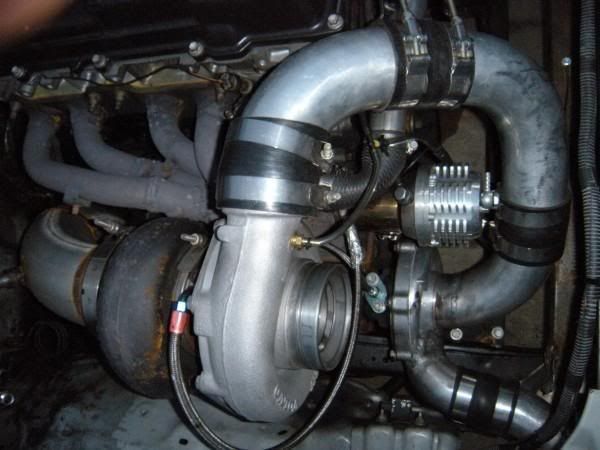
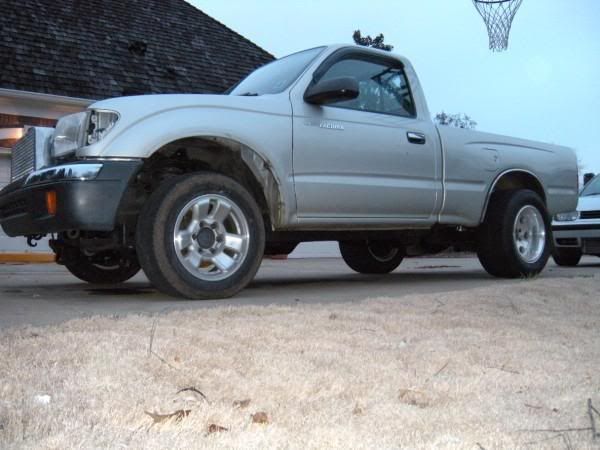

Wow this is one crazy set up, how's the drive on this Tacoma? must be quick as hell. :evil2:
And on the first pictures I love the set up on the 2JZ. I love when people are creative, also looks like and octopus has possession on the engine:sarcasm:
compound-tacoma;1257249 said:Actually, the math does add up!!! the problem is you aren't using the proper elements that are being affected. In any turbo setup weather gas or diesel you have to equate your manifold pressure in relation to absolute pressure(atmospheric pressure). Atmospheric pressure at sea level is 14.7psi or 1 bar. When a turbo makes boost it is simply compressing atmospheric pressure. So when a stock ct26 is making 14psi or 1bar there is actually 2 bar or 29.4psi coming out of the turbo, but you most subtract atmospheric pressure because it is neither created or lost(except in a vacuum).
So the simple equation is 1 bar(atmospheric pressure) + 1 bar(what the turbo produces) = 2bar - 1bar(atmospheric pressure) = 1 bar manifold pressure!!!! Thus the turbo is working in a 2:1 ratio.
Now when turbo's are compounded, one compressor is feeding the inlet of the second. The boost made by the first turbo is multiplied by the second turbo by a ration of 2:1 when using two turbos and 3:1 using three. and on, and on.
Example: 1bar(atmospheric pressure)+1bar(first turbo)=2bar, 2bar into second turbo(at a ratio of 2:1)=4bar-1bar(atmospheric pressure)=3bar manifold pressure!!!!!!
Thats 3bar or 45psi at the manifold, minus 2to3 psi for any loses like massive intercoolers and such. This is the secret that diesel guys have been using for years to make over 150psi with three turbo's compounded. And almost no one has tried it on any gas motors. I am currently running a compound setup on my 2000 Tacoma (pictured above). My brother and I have done all the fab. work and R&D. Running two 44mm wastgates with 4-7psi springs and no boost controller i've seen 25+psi before 3500rpms in 4th gear WOT. I'm running a GT45 into a TO4E t3/t4 50trim comparable to a GT30. The TO4E makes 5psi at 2krpms and the big one make 5psi around 3krpms. Some when the big turbo spools and the little one starts compounding it. The boost shoots from 10psi to 25psi+ with in 500rpms when loaded in 4th gear. Thats 25psi by 3500rpms!!!!! And my clutch starts slipping. Its is a stage 4 six puck competition clutch with 250% increase torque capacity, and it can't hold it since the power is coming on so FAST!!!!!!!
I'll be glad to answer any question. I'm going out of the country tomorrow and won't be back until the 9th. Vids will be up some time in march. I've been driving my truck daily since i got it running two months ago and no problems from the setup. Absolutely no lag!!!!!!!! In any gear traction is a problem:biglaugh: even thought i have a welded diff. and over 20in of rubber in the back. My intake temps are lower then when i was running a single TO4E at 10psi and I am running 15psi now. So there is no problem with running the big turbo into the little one, and it is way more efficient that way. How i pipe my setup might be confusing, and if it doesn't make since ask me specific questions and I'll give specific answers.
did you just try to explain to me what absolute pressure and call absolute in relation to atmospheric? REALLY?
First off. learn the proper terminology. Absolute pressure is in relation to the unachievable ZERO Kpa which does not exist, even in the near perfect "space" (10 kpa). When speaking in absolute values. There is no such thing as a "vacuum" as the minimum value will never ever be below zero (0 Kpa/PSIa). Now if you are talking in relation to Gauge pressure, then there is a "vacuum" in the sense that sea level is infact the reference point of measurement.
A turbo does not compress. A turbo flows. The pressure is the resistance to said flow which happens to be dependant on
1. Engine displacement for the given flow of air
2. VE of the engine for the given target RPM.
I am going to be quite frank.... PSIa inside of the intake manifold does not, will not, EVER IN THIS UNIVERSE equal to flow. EVER.
As IJ state before. the restriction and specifically dealing with critical V will be tied to the inlet of the smaller turbo since that is where the smaller restriction to the velocity of air is.
A simple understanding of Bernoulli's principle shows that for a given flow volume of air/liquid, decrease the area and the velocity has no choise but to increase. Increase the area and V decreases. Quite simple really.
Now on to you pressure ratio. at least you established that you understand that. But your data is dead wrong. Turbos do not get "better" because some magical gnomes are throwing pixie dust on the turbos and that"increase" or decrease PR. That is dependant on the turbo itself.
Now your setup.
Something magical happens. The GT30 (using GT3076r numbers which are close). If you limit the turbos flow to about 38 lbs/min. That turbo comes in around mid 2k RPM. This is assuming a 2.7L engine pushing it and assuming a redline of 6k RPM. A GT45? I am going to say not a TRUE Garret GT45 as there is no way in hell that 2.7L of engine will bring a true GT45 online until 7K+ rpm. So probably a variant of the SP61/PTE61 etc which those come online at the mid 3k RPM mark give or take.
On the 7m or 2jz.
A GT35r at a PR of 2. If it is not flowing between 35 lbs/min - 42 lbs/min will be going into a less efficent zone. The problem is that we know for a fact that the monster GT42RS turbo that is the primary turbo will not be helping with spool, AT ALL (high 4k RPM), on the lower end of the RPM spectrum. So the PR is not dependant on the big turbo as it is doing ZERO work at that point, PR is dependant on what has always been dependant on.
****DROLL ROLL****
displacement of the engine along with the VE of said engine.
So we get back to what I and the rest of the guys that actually studied physics have been saying, this still requires PROPERLY sized turbos. It is not a end all be all solution for turbo and two improperly sized turbo will net you nothing, as a matter of fact, net you some serious loss as you have increased entropy in the system by quite a significant amount.
The diesel engine you speak of, refresh my memory, how big displacement are they? 6L? Hell that is big enough to spin a GT42RS by themselves without to much issues within thier RPM range.
and I am saying it one more time.
Pressure DOES NOT EQUAL, and will never EQUAL FLOW.
What pressure is, a direct correlation to flow DEPENDANT on engine displacement along with it's VE.
IE
a LS7 will require less pressure to achieve X HP
a 2jz will require more pressure to acheve X HP
A 4G63 will require more pressure than the 2jz and LS7 to achieve X HP.
HP is a function of air flow NOT pressure (see the common theme
Read what I posted over and over and over.......
Understand the difference between them. once you do. Then come back in here and try one more time.
There is a reason that WRC uses a 32mm inlet restrictor on their turbo cars. No matter how much pushing or pulling there is, once critical V is reached. The party is OVER.
Now on your setup, you are using overlap to increase power but the T04e is a 500hp turbo by itself. This stuff is not really rocket science
Last edited:
I dont want to sound like an asshole or anything, but 1 bar is 14.5 psi not 14.7. 14.7 is 1 atmosphere..101,325 pascals. 1 bar is 100,000 pascals.
Wouldn't the first wastegate effectively increase the A/R of the first turbo though?

IJ.;1255342 said:xx size hole in the Turbine entry to turbo #1 sets the total volume that will flow through the system.
For sure if you read one of my early posts I said if it had a bypass of some sort that could work. (hadn't paid attention to the above pic at that stage)
Not sure on the math for the intake side as the concept doesn't interest me enough to crunch the numbers.
Not sure on the math for the intake side as the concept doesn't interest me enough to crunch the numbers.
IJ.;1257628 said:For sure if you read one of my early posts I said if it had a bypass of some sort that could work. (hadn't paid attention to the above pic at that stage)
Not sure on the math for the intake side as the concept doesn't interest me enough to crunch the numbers.
What kind of bypass valve exactly though? I mean, I understand the concept completely, but who makes a valve for this purpose? I'd be interested taking a look at how it would actually work on the new compound setup.
I am thinking about it from this point of view, if I had a small turbo with just say a 74mm turbo and wanted to use the valve because the inlet to the turbo was 2 inches. Just not big enough to effectively move air to make the compound setup really effective IMO. If that made no sense, forgive me because I'm spent
RacerXJ220;1257664 said:What kind of bypass valve exactly though? I mean, I understand the concept completely, but who makes a valve for this purpose? I'd be interested taking a look at how it would actually work on the new compound setup.
I am thinking about it from this point of view, if I had a small turbo with just say a 74mm turbo and wanted to use the valve because the inlet to the turbo was 2 inches. Just not big enough to effectively move air to make the compound setup really effective IMO. If that made no sense, forgive me because I'm spent
A normal run of the mill waste gate.......Except it has to be of significant size or double up on them. The trick is to open the waste gate from the first turbo at the right "time" to allow the energy to by pass the first turbo to go to the 2nd turbo for purpose of making the turbo spool up.
IE
a TiAl waste gate will work. Same with any other waste gate.
Let's look at BL's setup.
http://www.boostlogic.com/pics/supratt/compound/blcompoundstand1.jpg
We see that the waste gate is between the first turbo and the 2nd turbo which Y back into the exhaust stream prior to feeding the 2nd turbo and if you look closely, you will see a SMALLER waste gate about 3 inchches away from the big wastegate.
There is your answer
"turbos do not compress" is 50% false, it does compress. It is not a positive displacement compressor, but it absolutely compresses the air.figgie;1257453 said:Now your setup.
Something magical happens. The GT30 (using GT3076r numbers which are close). If you limit the turbos flow to about 38 lbs/min. That turbo comes in around mid 2k RPM. This is assuming a 2.7L engine pushing it and assuming a redline of 6k RPM. A GT45? I am going to say not a TRUE Garret GT45 as there is no way in hell that 2.7L of engine will bring a true GT45 online until 7K+ rpm. So probably a variant of the SP61/PTE61 etc which those come online at the mid 3k RPM mark give or take.
It is a Garret GT45, and I am running two boost gauges. One for manifold pressure, and one on the outlet of the GT45. In 3rd gear i am seeing 5psi on my big turbo gauge by 3200rpms. Why? there are several reasons 1.Because of how the exhaust is routed, and the diameter of the piping. Small diameter piping keeps the velocity up and the gases from fully expanding. Thus allowing the turbo's spool faster.
Also when running turbo's in compound all the cfm flowed by the little turbo at the lower rmp's is helping to spool the big turbo at low rmp's.
There are NO little fairys with pixy dust in my setup. I have hand built every aspect of my setup. manifolds, piping, stand-alone, fuel system, motor mounts, custom hybrid trans, fully built motor and modified head, custom suspension, and the list goes on...........
You know the "book or science" behind single turbo setups, but have you ever built any projects (and i'm not talking about kits installs)? Have you ever built a compound setup? Have you every used a compound setup,or even seen one in person? Because the last time i checked the earth is round and people used to say that was impossible.:icon_bigg
figgie;1257720 said:A normal run of the mill waste gate.......Except it has to be of significant size or double up on them. The trick is to open the waste gate from the first turbo at the right "time" to allow the energy to by pass the first turbo to go to the 2nd turbo for purpose of making the turbo spool up.
IE
a TiAl waste gate will work. Same with any other waste gate.
Let's look at BL's setup.
http://www.boostlogic.com/pics/supratt/compound/blcompoundstand1.jpg
We see that the waste gate is between the first turbo and the 2nd turbo which Y back into the exhaust stream prior to feeding the 2nd turbo and if you look closely, you will see a SMALLER waste gate about 3 inchches away from the big wastegate.
There is your answer
Had that answer Figgie, I was wondering about a bypass valve so that the larger turbo can move more air making the size of the first turbo irrelavent in terms of being the bottleneck.
compound-tacoma;1257774 said:"turbos do not compress" is 50% false, it does compress. It is not a positive displacement compressor, but it absolutely compresses the air.
It is a Garret GT45, and I am running two boost gauges. One for manifold pressure, and one on the outlet of the GT45. In 3rd gear i am seeing 5psi on my big turbo gauge by 3200rpms. Why? there are several reasons 1.Because of how the exhaust is routed, and the diameter of the piping. Small diameter piping keeps the velocity up and the gases from fully expanding. Thus allowing the turbo's spool faster.
Also when running turbo's in compound all the cfm flowed by the little turbo at the lower rmp's is helping to spool the big turbo at low rmp's.
There are NO little fairys with pixy dust in my setup. I have hand built every aspect of my setup. manifolds, piping, stand-alone, fuel system, motor mounts, custom hybrid trans, fully built motor and modified head, custom suspension, and the list goes on...........
You know the "book or science" behind single turbo setups, but have you ever built any projects (and i'm not talking about kits installs)? Have you ever built a compound setup? Have you every used a compound setup,or even seen one in person? Because the last time i checked the earth is round and people used to say that was impossible.:icon_bigg
You chose the wrong words.......
Turbo do not compress 50% of the time. They do not compress at ALL. Pressure is an effect to flow. Part of that whole fluid mechanics thing which is a branch of physics (and we will get to that in a bit). That is why turbos can be turned to "make-shift" turbines. FLOW NOT pressure.
A turbo flows. 2nd time I will give you this explanation. The pressure is based on displacement of the given engine along with VE during ceratin RPM's. The turbo flow but the engine impedes the flow (and technically, the valve opening and closing event on a petrol/gasoline engine).
1 turbo, 2 turbos, quad turbo in either compound, sequential or parallel setup, dual charging. They all play by the same rules of science, specifically, Kinematics, Thermodynamics and Fluid Dynamics.
On the compound system, again, no such thing as a free lunch. First law of thermodynmaics is that Energy can not be created nor destroyed, it just chages state. So that little turbo that is feeding the engine and then receiving the exhaust pulses first comes at a cost. The exhaust will lose energy by spining that first turbo. Again, just by the small turbo WORKING, means that energy is changing state to heat, frictional losses etc. That why turbo have the flow charts
As to your last statement. PEOPLE used to say that the earth was flat. SCIENCE (what I have been using so far) proved that the earth was "round-ish", Proved that the earth was not the center of this solar system, galaxy, universe among other nice discoveries that PEOPLE never understood and some don't today.
There is NO FREE LUNCH.
RacerXJ220;1257834 said:Had that answer Figgie, I was wondering about a bypass valve so that the larger turbo can move more air making the size of the first turbo irrelavent in terms of being the bottleneck.
Pop off valve.
Old indy car's had them set at 40 psi and they were pretty damn huge. Pop off valve set for something that opens and re-routes the air past #2 turbo at y PSI should do the trick.
Persoanlly for all this complexity that is being added, bigger displacement and call it a day.
figgie;1257867 said:Persoanlly for all this complexity that is being added, bigger displacement and call it a day.
Thought about that too figgie, but then I would have to pay all the maintanence on them, which is a butt load, not to mention the cost of the install and parts.
I would like something complex actually, if it worked as close to perfect as possible. It'd have a cool factor for sure.
If the pop off valve can bypass like they're supposed to, then holy hell this kit is going to rock. I am googling for one, but I can't find one. Little help here please??? Government computers don't like a lot of the sites and block them
I think it'd be easy to make routing for those, especially with the recirc fittings available.
its a cool looking setup, seems kinda like overkill with all the technology we have as far as antilag and what not. i saw a pic of a neon engine years ago with a similiar setup, not an srt4 either. im talking pre srt4. i never saw any specs or anything just that one pic. im not knocking the idea just dont see needing it on a gas engine.
RacerXJ220;1258574 said:Thought about that too figgie, but then I would have to pay all the maintanence on them, which is a butt load, not to mention the cost of the install and parts.
I would like something complex actually, if it worked as close to perfect as possible. It'd have a cool factor for sure.
If the pop off valve can bypass like they're supposed to, then holy hell this kit is going to rock. I am googling for one, but I can't find one. Little help here please??? Government computers don't like a lot of the sites and block themCouldn't I just use a BOV like a Greddy type S/R as the bypass valve set to open at low boost pressure? Could you adjust the point at which those kinds open?
I think it'd be easy to make routing for those, especially with the recirc fittings available.
well keep in mind that a BOV opens when there is a lower pressure than atmospheric on the valve. A pop off valve (found it, also known as a turbo relief valve.), opens when a predeterimined boost level is reached.
IE
old champ cars was 40 psi. after that it opened and vented the excess to the air.
btw, here is a link to greddy's version
http://www.greddy.com/img/PHP/products/jpg/560.jpg
Please correct me if I am wrong but ultimately would not the smaller compressor choke the system once it has reached its peak mass flow?
Larger than ambient pressures at the inlet of the compressor would allow for larger manifold pressures with lower PR but overall mass flow cannot exceed that of the smaller compressor.
Larger than ambient pressures at the inlet of the compressor would allow for larger manifold pressures with lower PR but overall mass flow cannot exceed that of the smaller compressor.


